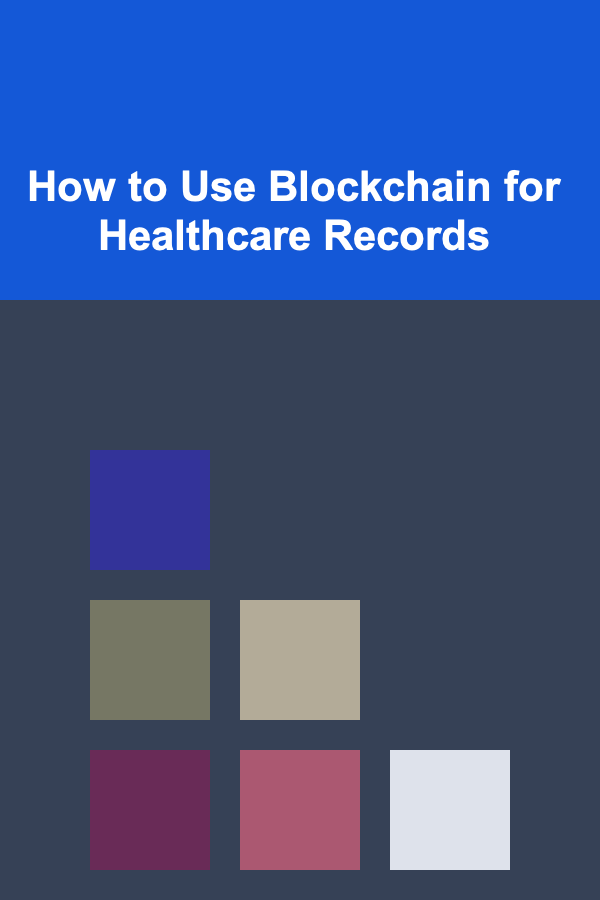
How to Use Blockchain for Healthcare Records
ebook include PDF & Audio bundle (Micro Guide)
$12.99$9.99
Limited Time Offer! Order within the next:

The healthcare industry has long struggled with the challenge of securely and efficiently managing medical records. With the rise of digital technologies, electronic health records (EHRs) became the standard, but they still come with issues related to privacy, security, and interoperability. Enter blockchain technology---widely known for its association with cryptocurrencies---offering a potential solution to these long-standing problems in healthcare.
This article explores how blockchain can be used to enhance healthcare records, focusing on its capabilities to ensure privacy, security, data integrity, and seamless interoperability. It will cover the basics of blockchain, its application in healthcare, the challenges faced by current systems, and the future of blockchain-based healthcare records.
Understanding Blockchain Technology
At its core, blockchain is a decentralized, distributed ledger technology that records transactions across multiple computers in such a way that the registered transactions cannot be altered retroactively without the alteration of all subsequent blocks and the consensus of the network. It operates on a peer-to-peer network, meaning there is no need for a central authority to validate transactions.
Blockchain's main features that make it appealing for healthcare records are:
- Immutability: Once a record is added to the blockchain, it cannot be changed or deleted. This ensures the integrity and authenticity of healthcare data.
- Transparency: Blockchain enables all parties involved in the healthcare process (e.g., patients, doctors, and healthcare providers) to access a single source of truth.
- Security: Blockchain employs advanced cryptographic techniques that make data tampering extremely difficult.
- Decentralization: By distributing data across a network of computers, blockchain eliminates the need for a central authority, which reduces the risk of data breaches or errors.
The Need for Blockchain in Healthcare Records
Challenges of Current Healthcare Systems
The management of healthcare records is complex and often fragmented, with multiple entities (hospitals, clinics, laboratories, insurance companies) storing different parts of a patient's data in isolated systems. Some key challenges include:
- Data Breaches and Cybersecurity Threats: Healthcare systems are prime targets for cyberattacks. According to a 2020 report by the U.S. Department of Health and Human Services, healthcare data breaches had a significant rise in recent years, putting patient data at risk.
- Interoperability: Healthcare systems often operate on different platforms and technologies, making it difficult to share information between healthcare providers. The lack of standardization and interoperability leads to inefficiencies, delays in treatment, and errors in diagnosis.
- Lack of Data Ownership and Control: In traditional systems, patients have limited control over who accesses their data, and the data is often stored in proprietary systems controlled by hospitals or insurance companies. This reduces patients' autonomy over their own healthcare information.
- Data Integrity: The accuracy of healthcare records is crucial. However, in some cases, errors in medical records or unauthorized modifications can result in incorrect diagnoses, ineffective treatments, or even medical malpractice.
Blockchain addresses all of these issues by offering a transparent, secure, and interoperable framework for managing healthcare records.
How Blockchain Works in Healthcare
Blockchain technology can be applied to healthcare records in various ways, primarily to create a secure and efficient platform for storing, sharing, and managing medical data. Here's a look at how blockchain functions in this context:
1. Decentralized Storage of Healthcare Data
Blockchain enables decentralized storage of medical records, ensuring that healthcare data is distributed across multiple nodes in the network. Each node contains a copy of the blockchain, making it impossible for a single entity to control or alter the data without the consensus of others. This ensures data integrity, as no single party can modify the records without detection.
Instead of having disparate systems in various healthcare institutions, patients can have their health records stored in a secure, shared, decentralized network. Patients can grant access to different stakeholders (doctors, specialists, insurers) based on their needs.
2. Ensuring Data Security and Privacy
In traditional healthcare systems, patient data is often stored in centralized databases, which are vulnerable to hacking and data breaches. Blockchain provides a higher level of security through its cryptographic features, such as hash functions, public-private key encryption, and digital signatures.
- Encryption: Blockchain records are encrypted, so only authorized parties with the appropriate keys can decrypt and access the data.
- Access Control: Patients have control over who can access their health records, which can be managed using private keys or digital signatures.
- Audit Trails: Blockchain's immutability ensures that any access to a patient's medical records is recorded and can be audited. This creates an additional layer of accountability and reduces the risk of unauthorized access.
3. Data Interoperability
One of the most significant barriers to improving healthcare efficiency is the lack of interoperability between different healthcare systems. Blockchain can help by providing a unified framework for sharing data across various platforms.
Since blockchain is decentralized, healthcare providers can access and update patient records in real-time, without relying on a central authority. Blockchain can enable seamless data sharing between healthcare organizations, ensuring that information is always up-to-date and accessible, regardless of the system or platform being used.
Additionally, blockchain can support data standards and protocols, ensuring that the data being exchanged is compatible across various healthcare systems.
4. Smart Contracts and Automation
Smart contracts are self-executing contracts with predefined conditions written into code. In healthcare, smart contracts can be used to automate various processes, such as billing, insurance claims, and patient consent management.
For example, a smart contract could be programmed to automatically process insurance claims when certain conditions are met, reducing administrative overhead and errors. Similarly, smart contracts could be used to manage patient consent for sharing their data with specific healthcare providers, ensuring that only authorized parties have access to the information.
5. Real-Time and Immutable Medical Records
Blockchain's immutability means that once medical data is added to the blockchain, it cannot be altered. This ensures the integrity of medical records, reducing the risk of data manipulation or loss. With real-time updates, doctors can access the most up-to-date patient data, making better-informed decisions for treatment.
Additionally, if a medical error occurs or a mistake is made in a patient's record, it can be tracked and rectified through an immutable audit trail, increasing transparency and trust.
Benefits of Using Blockchain for Healthcare Records
The integration of blockchain technology into healthcare records offers numerous benefits for patients, healthcare providers, and the entire healthcare system.
1. Enhanced Security and Privacy
Blockchain's decentralized and encrypted nature ensures that healthcare data is highly secure. Since the records are immutable, there's little to no risk of data tampering, making healthcare systems more resilient to cyberattacks and fraud. Moreover, patients can retain control over who has access to their personal health data, preserving privacy.
2. Improved Data Integrity
With blockchain, all medical records are stored in a single, immutable ledger that cannot be altered without consensus from all participants. This means that the data is always accurate and up-to-date, reducing the risk of errors in diagnoses and treatment plans. It also eliminates the possibility of fraudulent data being introduced into the system.
3. Increased Interoperability
Blockchain can create a common framework for exchanging healthcare data across different systems. This improves interoperability by ensuring that medical records can be shared seamlessly between hospitals, clinics, insurance providers, and other healthcare organizations. Interoperability is crucial for improving patient care, reducing redundant tests, and ensuring that patients receive consistent treatment across different providers.
4. Streamlined Administrative Processes
Blockchain can automate various administrative processes through smart contracts. This includes things like billing, insurance claims, and patient consent management. By automating these processes, healthcare organizations can reduce administrative costs, improve efficiency, and focus more on patient care.
5. Empowerment of Patients
With blockchain, patients gain greater control over their health data. They can choose which healthcare providers can access their records, track who has accessed their data, and revoke access at any time. This empowers patients by giving them more autonomy over their health information.
Challenges and Limitations of Blockchain in Healthcare
Despite its potential, the adoption of blockchain technology in healthcare faces several challenges:
1. Regulatory and Legal Issues
The healthcare industry is heavily regulated, and blockchain's decentralized nature presents challenges when it comes to compliance with laws such as HIPAA (Health Insurance Portability and Accountability Act). The healthcare sector will need to develop new frameworks and regulations to accommodate blockchain-based systems.
2. Scalability
Blockchain networks can become slow and expensive as they grow in size. For healthcare, where large amounts of data need to be stored and accessed quickly, scalability is a significant concern. The current blockchain infrastructure may not be suitable for handling the massive volume of healthcare data in a timely manner.
3. Integration with Legacy Systems
Many healthcare organizations still rely on legacy systems that are not compatible with blockchain technology. The integration of blockchain with these existing systems can be complex and costly. A gradual transition to blockchain-based systems will be necessary to overcome this challenge.
4. Adoption and Education
For blockchain to be successful in healthcare, all stakeholders (patients, doctors, administrators, insurers, etc.) need to understand the technology and its benefits. There will be a significant learning curve and resistance to change from those accustomed to traditional methods of data management.
Conclusion
Blockchain technology holds tremendous promise for revolutionizing the way healthcare records are managed. By providing a secure, transparent, and decentralized system for storing and sharing medical data, blockchain can enhance the security, privacy, and integrity of healthcare information. While there are challenges to overcome, particularly around scalability and regulatory compliance, the potential benefits make blockchain a viable solution for addressing the issues that have long plagued healthcare systems. As the technology matures and adoption increases, blockchain could play a pivotal role in transforming healthcare for the better.

How to Assess the Effectiveness of Your Current Soundproofing Measures
Read More
How To Find Your Niche in Your Industry
Read More
How to Make Money Online as a Recruiter: 10 Actionable Ideas
Read More
How to Organize Markers, Crayons, and Colored Pencils
Read More
How to Use a Calendar for Holiday Decoration Planning
Read More
Understanding Orbital Mechanics: A Deep Dive
Read MoreOther Products

How to Assess the Effectiveness of Your Current Soundproofing Measures
Read More
How To Find Your Niche in Your Industry
Read More
How to Make Money Online as a Recruiter: 10 Actionable Ideas
Read More
How to Organize Markers, Crayons, and Colored Pencils
Read More
How to Use a Calendar for Holiday Decoration Planning
Read More